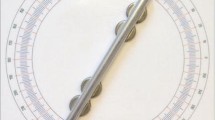Abstract
Haptic matching of the orientation of bars separated by a horizontal distance leads to large systematic deviations. This finding leads to the following intriguing question which we investigated in this study: How will a bar moving from left to right in a fixed orientation be perceived by blindfolded observers? Interestingly, this previous finding predicts that the translating bar will cause the illusory perception of a rotation. In our experiment, we used psychophysical methods to determine the rotation needed to perceive the bar as non-rotating, for both rightward and leftward translations. From our results, it can be estimated that, on average, a bar translating in parallel over 60 cm is perceived as rotating 18°, so we established that the predicted illusory rotation indeed exists. This implies that static and dynamic signals are processed in a similar way.




Similar content being viewed by others
References
Blumenfeld W (1913) Untersuchungen über die scheinbare Grösse im Sehraume. Zeitschrift für Psychologie 65:241–404
Blumenfeld W (1937) The relationship between the optical and haptic construction of space. Acta Psychol 2:125–174
Carrozzo M, Lacquaniti F (1994) A hybrid frame of reference for visuo-manual coordination. NeuroReport 5(4):453–456
Coren S (1993) The left-hander syndrome: the causes and consequences of left-handedness. Vintage Books, New York
Cuijpers RH, Kappers AML, Koenderink JJ (2000) Large systematic deviations in visual parallelism. Perception 29(12):1467–1482
Fernández-Díaz M, Travieso D (2011) Performance in haptic geometrical matching tasks depends on movement and position of the arms. Acta Psychol 136(3):382–389
Gentaz E, Baud-Bovy G, Luyat M (2008) The haptic perception of spatial orientations. Exp Brain Res 187(3):331–348 doi:10.1007/s00221-008-1382-0
Kaas A, van Mier H (2006) Haptic spatial matching in near peripersonal space. Exp Brain Res 170:403–413
Kappers AML (1999) Large systematic deviations in the haptic perception of parallelity. Perception 28(8):1001–1012
Kappers AML (2003) Large systematic deviations in a bimanual parallelity task: Further analysis of contributing factors. Acta Psychol 114(2):131–145
Kappers AML (2004) The contributions of egocentric and allocentric reference frames in haptic spatial tasks. Acta Psychol 117(3):333–340
Kappers AML (2007) Haptic space processing—allocentric and egocentric reference frames. Can J Exp Psychol 61(3):208–218
Kappers AML, Koenderink JJ (1999) Haptic perception of spatial relations. Perception 28(6):781–795
Kappers AML, Schakel WB (2011) Comparison of the haptic and visual deviations in a parallelity task. Exp Brain Res 208(3):467–73 doi:10.1007/s00221-010-2500-3
Newport R, Rabb B, Jackson SR (2002) Noninformative vision improves haptic spatial perception. Curr Biol 12(19):1661–1664
Paillard J (1999) Motor and representational framing of space. In: Paillard J (ed), Brain and space. Oxford University Press, Oxford, pp 163-182
Soechting JF, Flanders M (1992) Moving in three-dimensional space: frames of reference, vectors, and coordinate systems. Annu Rev Neurosci 15:167–191
von Skramlik E (1937) Psychophysiologie der Tastsinne. Akademische Verlagsgesellschaft, Leipzig
Zuidhoek S, Kappers AML, van der Lubbe RHJ, Postma A (2003) Delay improves performance on a haptic spatial matching task. Exp Brain Res 149(3):320–330
Acknowledgments
The authors thank Zimma Kluit for performing pilot experiments. This research was supported by the Netherlands Organisation for Scientific Research (NWO).
Author information
Authors and Affiliations
Corresponding author
Rights and permissions
About this article
Cite this article
Kappers, A.M.L., Bergmann Tiest, W.M. Illusory rotation in the haptic perception of a moving bar. Exp Brain Res 231, 325–329 (2013). https://doi.org/10.1007/s00221-013-3695-x
Received:
Accepted:
Published:
Issue Date:
DOI: https://doi.org/10.1007/s00221-013-3695-x



